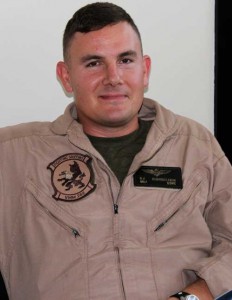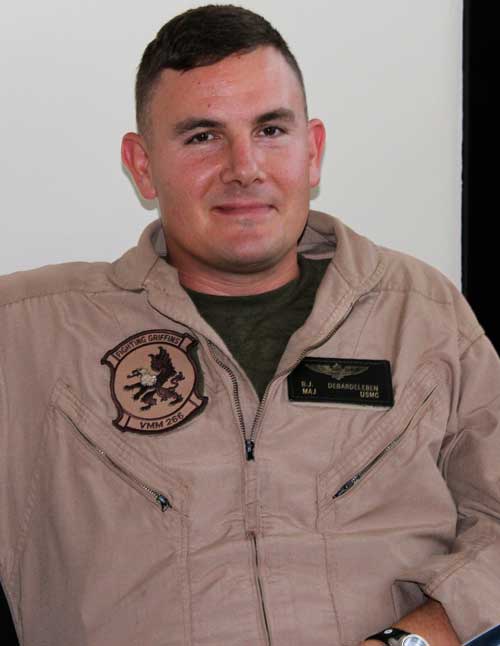An Interview with Major Debardeleben
09/27/2011 – During the annual Second Line of Defense visit to New River to discuss Osprey operations and experiences with the Osprey Nation, we had a chance to discuss the TRAP mission over Libya with the ACE commander and with one of the Osprey operators involved in the mission. Earlier we discussed this mission with the MEU commander.
In this interview Maj. B.J. Debardeleben discussed the mission after take off from the ship off of the coast of Libya.

After we took off, the autopilot took over. That is one of the great things on this plane versus the SEA KNIGHT is that it can fly itself through part of the operation. In a car, if you can set speed control, you can now be able to use your mind and do something else and focus on the road. And it’s exactly what we did on the plane and you’re monitoring the flying, but now you’re able to manage the mission better.
We were focusing on shaping our way to the moving recovery zone. We compared the mission plan to the unfolding operation. Let’s look at this, figure out some more things, and to make sure everything’s right that we did with our mission planning before we left the boat. So it gave us time to assess everything with the radio, talk to people we needed to, and build our situational awareness.
We immediately started talking to the Harrier operating above us. And he starts talking with the pilot and we can hear one side of the conversation and I can tell that things are getting worse on the ground.
We made the judgment that we had to accelerate the mission. We moved towards our top speed as the pilot was moving to a new location on the ground.
The pilot on the ground indicated that “they’re still going at us, and things are getting worse.” And he is clearly on the move.
We had the grid of the plane crash site and we got a new grid and realized that it was much further away from where the original crash site was. So he’d been on the move the whole time.
If I had been flying a SEA KNIGHT, by the time I had gotten the new information with regard to the shift in the grid, and flown for the 40 minutes under those conditions, I would have been relatively exhausted by the time I got there because you’re holding the controls, and you’re getting shaken the whole time.
On the Osprey, I am on autopilot. So I can take a sip of water, I’m assessing everything, and I’m listening to what’s going on very clearly. The V22s very quiet in airplane mode so we can hear the radios very well, but if I was in a SEA KNIGHT the noise would make it difficult to hear. The grunts in the back were able to look at a moving map that they can look at to have both SAs when we’re getting closer and closer to coast line.
And so in that flight task now they’re relaxed and comfortable instead of them shaking in the back because usually with all the shaking makes you groggy you sleep, so you have to wake them up when you land. So they’re in the back at least relaxed and calm before we drop them off.
We zoom all the way in, we get about ten miles off the coast, I drop down from 500 feet to about 200, 300, feet just to stabilize radars. Looking at the coastline, and I was expecting Libya to look Djibouti which presents a very dark profile. But it was light up, with the electricity grid.
And so we just picked a dark spot. We also had a visual map. So now I’m looking at where I’m going to fly, I look at it on the map and I say, “I’m going through there.”
Another thing I didn’t have in the SEA KNIGHT was that actual navigation. I had been holding a map with a flashlight trying to figure stuff out while the other person’s flying and shaking and you got to be able to do this without knowing where you’re going. With the terrain guidance you can make a rapid assessment of the terrain and how you are going to fly over that terrain.
Where you’re in a V22 you look at it and you get all the data right in front of you. It’s basically like having a smart phone versus using a dial telephone. All these things are helping you out in a difficult situation.
So they give me a new grid, and I’m looking for my needle, to where I’m supposed to go, a large town, and then I’ll look outside and I see a large town full of lights and probably that was an area the downed pilot was running from.
So I adjust my course a little bit to the left, go through the dark area, and then come through. I’m seeing pilot lines; I can mark all sorts of things on my map.
I’m flying inbound, the Harrier has built a picture for me, and he’s talking to me, telling me what I’m going to see, what the road looks like, where he is. Gives me that updated grid.
The F15 and F16 are now back on station and they start talking. They’re doing a good job of talking to the downed pilot and they know who he is, you know, they’re friends with him. They encourage him to have a drink of water and to calm down and to just stay where we was now.
Earlier, there was commotion going on at the response station, there’s people chasing him, and there’s cars chasing him. The Harrier used various means to kind of scare people away from him. That’s when he said,” say good bye to my wife”. I could hear in my guy’s voice that things were getting more serious.
One nice thing also about having people overhead is that they are in calmer environment able to look at the situation and give you more information. “Hey Ospreys, you guys have DF?” They said “ we have DF,” so they put it up, and cue somebody one, two, three, four, five, that other needle swings over on top of my navigation needle, now saying that he’s generally in that area that you’re headed towards.
The joint quality of the operation is important. One of the best things I think about it is, that we are joint enough in terminology and techniques and everything all relatively the same. You know, we may have differences that are minute, but our terminology is all the same and we can interop wherever we have to in such a situation
In fact, I learned later that we went to introductory aviation school together in Pensacola. When I went down to visit him in the hospital, we realized that we went to school together at Pensacola. You just never get how small the world’s going to get when somebody comes back from 11 years ago.
So we’re coming in. One of the other best things about the Osprey is so, besides it being comfortable for us, it is quiet on the outside in airplane mode. Nobody’s going to hear us until we’ve gone past them. And it just sounds like a whisper rush. And at night you’re not going to know anything about it. The SEA KNIGHT or any helicopter, you are hearing it from 10 to 15 miles away, you’re not going to hear anything from us until we’re at least beyond you.
But as I’m coming in, I hear him, he’s very quiet at this point, and I can hear the dogs barking in the background starting in my mind to envision where he is and what’s going on. And they’re talking about the vehicles pushing northwest and nobody knows where he is at that point, so it’s looking good. And so we’re all starting out thinking about where we’re going to land. And that zone wasn’t described as to what the surface was. He just said land it by this road.
We have an inertial navigation system, so get when I say plot of our plane in time and space. And so if we set up to land, we get a velocity vector that shows our movement on the earth and you don’t have to look outside to land.
And it’s an awesome capability because when the helo goes up, if you look at it and you look at gusts and the way it flows, it looks like it’s moving. Your helo is going backwards and it becomes very confusing for the helicopter pilot. And it’s always been one of the hardest things for us to do is land in the desert safely.
And in the Osprey they have fixed it. We can do this manually looking at the system, or the plane can fly itself to hover, and land directly down, you know, no questions asked, and it is amazing; both ways work 100 percent of the time.
As we’re coming to land we start to turn into a helicopter and we’re setting up to land. And as soon as we speed the motor blades up and then started bringing out, the noise comes on. And it is loud.
And as soon as I do that, the downed pilot starts yelling on the radio, he’s like “Don’t leave me, I hear you.” And I was like, “Hey we got it, we know where you are, we’re coming, you know, send your flare up.”
So he sends his signal early, it’s a high light night, very bright, a few clouds in the sky; it was just really not good for such a mission to go down. I get over him as he’s starting to talk as my crew chief finally says, you know, “I see him.”
We get a sparkle of the F16 and marks the spot. My guy comes in and lands right beside him, we’re pretty much about 20 feet away from him. He jumps up, hands up, you know, no sign of radio or pistol or anything, he said he never even pulled his pistol out of his holster the whole time.
He runs to the plane, pretty much jumps on, and sits down and puts on his seat belt and he’s like, “I’m ready to go.” The grunts spread out, to secure the zone for a second. Crew chief runs out there and grabs him, says everybody get back on the plane.
As I’m coming around I ask, “Do you have him on board?” I am told “Yup, my guy’s on.”
Because I am the second Osprey accompanying the one, which landed, I don’t even land I kind of come up beside him, I keep going, they pick up and then all together we leave.
The success of the mission was due in part to significant training. We trained for seven months as a team to do this. And then every time we had a chance on a boat in Djibouti or wherever we were, we trained to TRAP also. Because it’s the one way we can get the grunts on the back of the plane where we can use the jets overhead to work together and then land in the zone.


